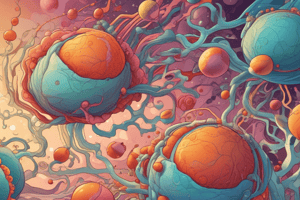Podcast
Questions and Answers
What is the most abundant porphyrin in nature?
What is the most abundant porphyrin in nature?
- Hemoglobin
- Chlorophylls (correct)
- Mycoblobin
- Catalase
What metal atom is chelated to the nitrogen atoms of the pyrrole units in heme?
What metal atom is chelated to the nitrogen atoms of the pyrrole units in heme?
- Magnesium
- Zinc
- Copper
- Iron (correct)
How much heme is synthesized daily for conjugation with the newly synthesized globin protein?
How much heme is synthesized daily for conjugation with the newly synthesized globin protein?
- 6-8 grams
- 750 grams
- 120 days
- 300 milligrams (correct)
Which protein acts as an oxygen carrier in the blood?
Which protein acts as an oxygen carrier in the blood?
What process uses about 14% of the dietary amino acids?
What process uses about 14% of the dietary amino acids?
What is the role of myoglobin?
What is the role of myoglobin?
Which metal atom is chelated to the nitrogen atoms of the pyrrole units in chlorophyll?
Which metal atom is chelated to the nitrogen atoms of the pyrrole units in chlorophyll?
What is the main function of cytochrome P450?
What is the main function of cytochrome P450?
How often is hemoglobin replaced in the body?
How often is hemoglobin replaced in the body?
What percentage of dietary amino acids is used for normal Hb turnover?
What percentage of dietary amino acids is used for normal Hb turnover?
Flashcards
Most abundant porphyrin in nature
Most abundant porphyrin in nature
Chlorophylls are the most abundant porphyrins in nature, playing a crucial role in photosynthesis.
Metal in heme
Metal in heme
Iron (Fe) is the metal atom chelated to the nitrogen atoms of the pyrrole units in heme.
Daily heme synthesis
Daily heme synthesis
Around 300 milligrams of heme are synthesized daily to bind with newly formed globin proteins.
Oxygen carrier in blood
Oxygen carrier in blood
Signup and view all the flashcards
Hemoglobin turnover
Hemoglobin turnover
Signup and view all the flashcards
Oxygen storage in muscle
Oxygen storage in muscle
Signup and view all the flashcards
Metal in chlorophyll
Metal in chlorophyll
Signup and view all the flashcards
Function of cytochrome P450
Function of cytochrome P450
Signup and view all the flashcards
Hemoglobin lifespan
Hemoglobin lifespan
Signup and view all the flashcards
Percentage of amino acids used for Hb turnover
Percentage of amino acids used for Hb turnover
Signup and view all the flashcards
Study Notes
Heme and Hemoglobin
- Protoporphyrin IX is the most abundant porphyrin in nature.
- In heme, an iron (Fe) atom is chelated to the nitrogen atoms of the pyrrole units.
- Approximately 300-400 mg of heme is synthesized daily for conjugation with newly synthesized globin protein.
- Hemoglobin acts as an oxygen carrier in the blood.
Myoglobin and Chlorophyll
- Myoglobin plays a role in storing oxygen in muscles.
- In chlorophyll, a magnesium (Mg) atom is chelated to the nitrogen atoms of the pyrrole units.
Protein Synthesis and Turnover
- The process of hemoglobin synthesis uses about 14% of the dietary amino acids.
- The main function of cytochrome P450 is to facilitate the degradation of hemoglobin.
- Hemoglobin is replaced every 120 days in the body, with about 1-2% of it being replaced daily.
- Approximately 14% of dietary amino acids are used for normal hemoglobin turnover.
Studying That Suits You
Use AI to generate personalized quizzes and flashcards to suit your learning preferences.
Description
Test your knowledge of heme metabolism and the functions of porphyrins as prosthetic groups for important proteins like hemoproteins involved in oxygen transport, breakdown of peroxides, electron transport, and hydroxylation. Explore the synthesis and degradation of heme in this metabolic process.




